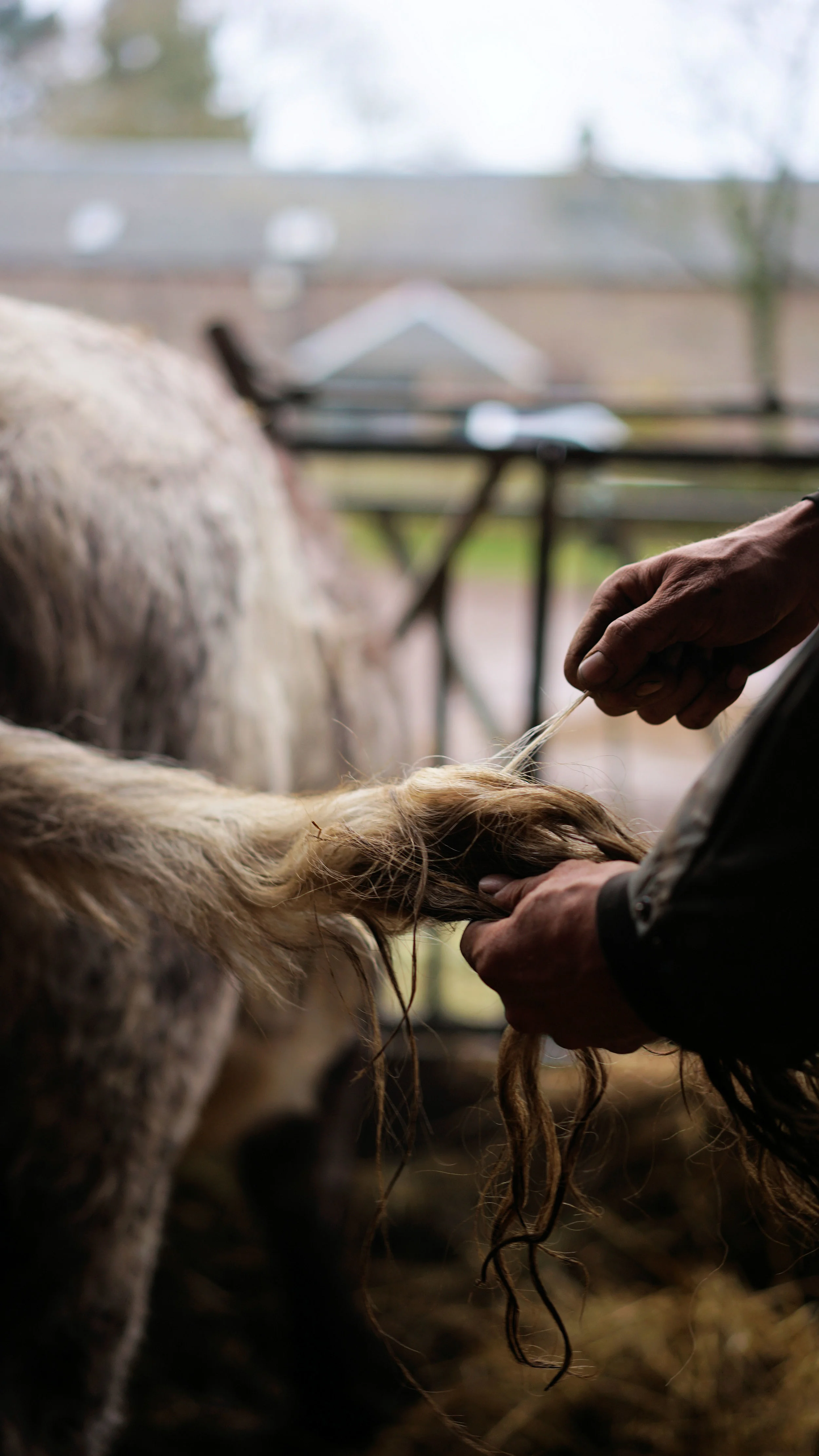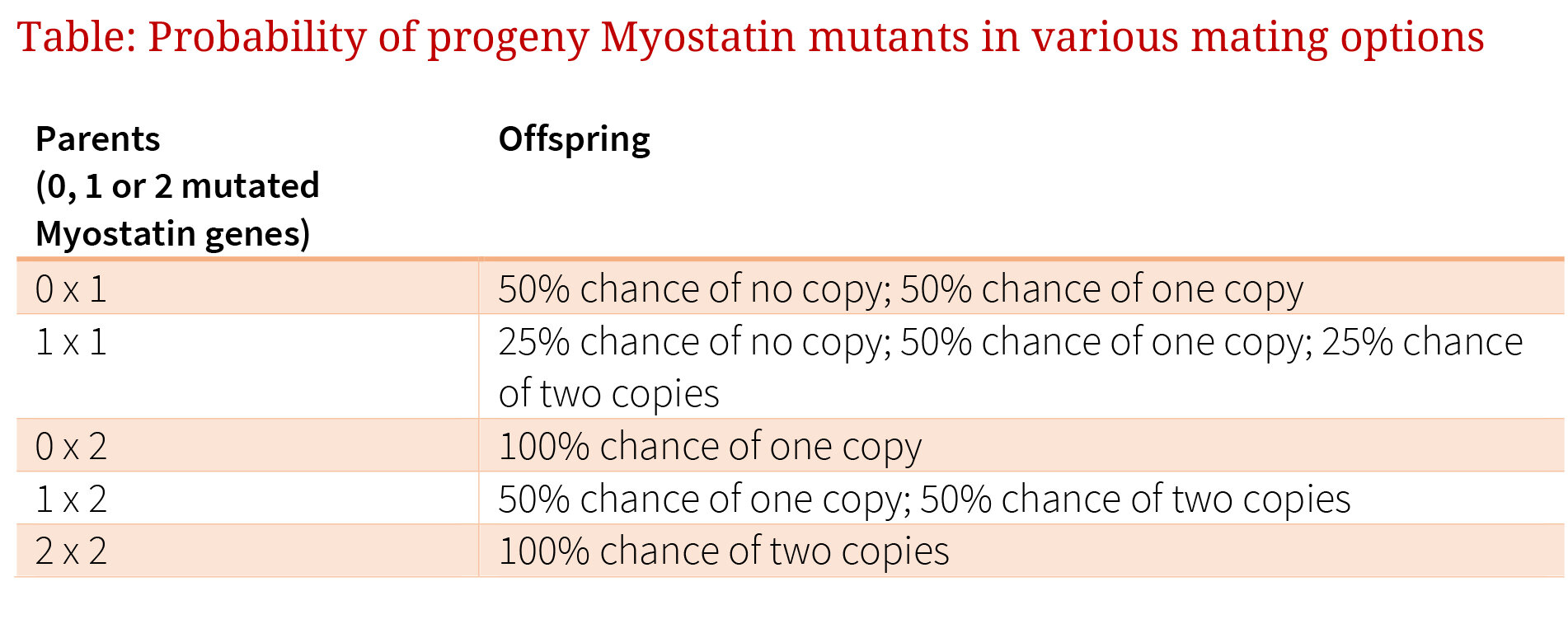Myostatin and its use in Beef Shorthorn breeding
Previously, Carey Coombs wrote a very useful article on Myostatin and this was published in the Beef Shorthorn Journal for 2019. This follow up article is to share information that can be of use in Beef Shorthorn breeding programmes.
The first thing to say is that we often talk about Myostatin as though it is the gene that creates muscled or double muscled animals. In fact, the natural version or the Wild Type (wt) gene has the function of limiting muscle growth. Indeed, the very name Myo meaning muscle and Statin means ‘to stop or stand still’ reflects its role. It is the mutated form which leads to increased muscle development.
Across the animal kingdom there appears to be a version of the myostatin gene in most animals analysed. In animal evolution (certainly for mammals) myostatin must have given an evolutionary advantage and is therefore important in the viability of an animal.
The issue for us cattle breeders is that this gene in different cattle breeds has experienced different types of mutation. For Beef Shorthorns the predominant mutations are named E226X (the most common) and nt419 (other mutations do occur however). When the myostatin gene is mutated the protein it produces (which is what does the work of limiting muscular growth), loses all or part of its function. The consequence is increased muscling and some other physiological changes.
A little bit of science is relevant here. A gene is an area on the DNA that codes for a protein. Proteins are large chain like molecules made up of different amino acids that can serve as structural building blocks (like keratin), hormones (like insulin), enzymes (like amylase in your saliva), and messengers and receptors to communicate between cells (essentially telling cells when and how to grow or to perform functions).
For simplicity here you can imagine the DNA like one side of a zip. When the zipper moves along the strand, it leads to a process where the 20 available types of amino acids which make up proteins are uniquely ordered along its length and together these form the specific proteins encoded by a particular gene. When that protein chain comes free of the ‘zipper’, it springs into a 3D shape that shape gives it its function. With Myostatin, the protein shape enables it to ‘tell’ muscle cells to limit their growth (a bit like putting a key in a lock). If it is mutated the protein shape can be either very different so the ‘key’ might not work at all (sometimes described as fully disruptive) or only work partially.
Animals inherit two copies of each gene (from their sire and dam respectively). If the progeny animal has only one copy of a mutated gene (heterozygous) then a non-functional or partially functional Myostatin (from one parent) can be partially compensated by the unmutated or wild type version from the other parent. If both copies are mutated then that can mean for a fully disruptive mutation (like E226X, nt419 and F94L) then no wild type function is present and the animal will be heavily muscled with possibly other physiological characteristics (some of which may be detrimental).
One question that comes up is: if the deletions on a double copy animal are at different places on the gene (eg. one at E226X and the other at nt419), can’t they be considered just like a single copy animal? The answer is a categoric ‘no’ because it doesn’t really matter about the location of the deletion in this context. Both copies of the protein will be non-functional or poorly functional and the animal will still exhibit the double copy mutation phenotype.
There is no doubt that partial loss of the functional Myostatin protein as happens with single copy inheritance confers some configuration benefits. But it’s worth noting that Myostatin is not the only protein that has a job to do in building the musculature of cattle. The other genes and their proteins in this developmental sequence are poorly understood. As breeders we often see that well-muscled animals can be bred without any Myostatin deletions and that equally, some single copy cattle don’t seem to have configurations much different from those without mutations.
What we do know is, that double copy animals are observed to have more pronounced musculature although it is interesting that in most shorthorns with double copies, they don’t exhibit the very extreme musculature of Belgian Blues. This supports the notion that there is more going on than just the Myostatin gene. In time, scientists will no doubt identify the developmental sequence upstream and downstream of the Myostatin protein. Until then, we have to use a Stockman’s eye supported by knowledge of the Myostatin status of our breeding animals, to inform our breeding choices.
Why is it important to know the Myostatin status? The answer is simple and scientifically researched: alongside the carcase benefits, myostatin deletions lead to other less beneficial consequences which include reduction in female fertility, lower viability of offspring, and delay in sexual maturation. These are amplified in double copy animals. Higher birth weights; difficult births and poorer milk yield.
I know this first-hand where we have had one or two 60-70Kg calves (tested subsequently and found to carry double copy mutations). This leads to potential calf death; interestingly not so much the problem of big hips, but the sheer body size of the calf crushing the umbilicus in the birth canal. Difficult births put the cow at risk too and the possibility of losing a calf and cow is neither humane nor economically acceptable. It also risks damaging the reputation of Beef Shorthorns as easy calving.
In our herd we now test all our animals (male and female) because we consider the risk of a double copy mating is too high (a 25% chance if both animals are single copy and a 50% chance if a single copy animal is mated with a double copy animal – see table at the end of this article). Indeed, we now pay very special attention to the Myostatin status of any bull we use.
In summary, single copy myostatin mutations have in many people’s minds, improved the ‘commercial’ credibility of the Beef Shorthorn to a wider audience. There are benefits to achieving more ‘beef character’ through informed use of Myostatin mutants. However, there is also a potential cost to breeding decisions where Myostatin status is unknown and there is a reputational risk to the breed when Bulls used commercially with either single copy or double copy mutations are used on other breeds or crosses that may also carry Myostatin deletions.
It is also worth thinking about what sort of beef is going to be demanded by the market in the future. Markets are beginning to develop for beef from native breed cattle based on eating quality, marbling and flavour. These characteristics are well embedded in the traditional shorthorn genetics as also are the maternal characteristics which allowed the breed to become the ‘great improver’. If we continue to increase the prevalence of Myostatin mutations in the breed, those characteristics could well be diminished.
The current carcase requirements for conformation and muscling to service a volume protein market may change as the public and media question meat eating and demand the ‘story behind the beef production’. A market for less beef but of better eating quality and with environmental credentials and provenance will potentially lend itself more to forage based systems and inputs perceived as more ‘natural’. The Beef Shorthorn is well placed to position itself as a breed that does all of this and more. However, a careful eye on sensibly exploiting the Myostatin deletions for the current market while conserving the breed’s other attributes may serve dividends in keeping the Beef Shorthorn relevant to future markets.
Important note: to help breeders make more informed choices the Society will cover the cost of Myostatin deletion testing on first time breeding heifers.
About the author
Timothy Riley is a Director of the Beef Shorthorn Society and a livestock farmer for over 25 years; breeding Beef shorthorns since 2009. He has written this article based on his direct experience in breeding cattle and his knowledge of genetics (he has a PhD in genetics from Kings’ College, Cambridge University and is a member of the DEFRA Farm Animal Genetic Resources Committee).


